[English] 日本語
 Yorodumi
Yorodumi- PDB-1ati: CRYSTAL STRUCTURE OF GLYCYL-TRNA SYNTHETASE FROM THERMUS THERMOPHILUS -
+ Open data
Open data
- Basic information
Basic information
| Entry | Database: PDB / ID: 1ati | ||||||
|---|---|---|---|---|---|---|---|
| Title | CRYSTAL STRUCTURE OF GLYCYL-TRNA SYNTHETASE FROM THERMUS THERMOPHILUS | ||||||
 Components Components |
| ||||||
 Keywords Keywords | PROTEIN BIOSYNTHESIS / LIGASE / SYNTHETASE / AMINOACYL-TRNA SYNTHETASE | ||||||
| Function / homology |  Function and homology information Function and homology informationglycine-tRNA ligase complex / glycyl-tRNA aminoacylation / glycine-tRNA ligase / glycine-tRNA ligase activity / glycine binding / protein dimerization activity / magnesium ion binding / ATP binding / identical protein binding Similarity search - Function | ||||||
| Biological species |   Thermus thermophilus (bacteria) Thermus thermophilus (bacteria) | ||||||
| Method |  X-RAY DIFFRACTION / X-RAY DIFFRACTION /  SYNCHROTRON / SYNCHROTRON /  MIR / Resolution: 2.75 Å MIR / Resolution: 2.75 Å | ||||||
 Authors Authors | Logan, D.T. / Mazauric, M.-H. / Kern, D. / Moras, D. | ||||||
 Citation Citation |  Journal: EMBO J. / Year: 1995 Journal: EMBO J. / Year: 1995Title: Crystal structure of glycyl-tRNA synthetase from Thermus thermophilus. Authors: Logan, D.T. / Mazauric, M.H. / Kern, D. / Moras, D. #1:  Journal: J.Mol.Biol. / Year: 1994 Journal: J.Mol.Biol. / Year: 1994Title: Crystallisation of the Glycyl-tRNA Synthetase from Thermus Thermophilus and Initial Crystallographic Data Authors: Logan, D.T. / Cura, V. / Touzel, J.P. / Kern, D. / Moras, D. | ||||||
| History |
|
- Structure visualization
Structure visualization
| Structure viewer | Molecule:  Molmil Molmil Jmol/JSmol Jmol/JSmol |
|---|
- Downloads & links
Downloads & links
- Download
Download
| PDBx/mmCIF format |  1ati.cif.gz 1ati.cif.gz | 192.2 KB | Display |  PDBx/mmCIF format PDBx/mmCIF format |
|---|---|---|---|---|
| PDB format |  pdb1ati.ent.gz pdb1ati.ent.gz | 154 KB | Display |  PDB format PDB format |
| PDBx/mmJSON format |  1ati.json.gz 1ati.json.gz | Tree view |  PDBx/mmJSON format PDBx/mmJSON format | |
| Others |  Other downloads Other downloads |
-Validation report
| Arichive directory |  https://data.pdbj.org/pub/pdb/validation_reports/at/1ati https://data.pdbj.org/pub/pdb/validation_reports/at/1ati ftp://data.pdbj.org/pub/pdb/validation_reports/at/1ati ftp://data.pdbj.org/pub/pdb/validation_reports/at/1ati | HTTPS FTP |
|---|
-Related structure data
| Similar structure data |
|---|
- Links
Links
- Assembly
Assembly
| Deposited unit | 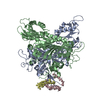
| |||||||||
|---|---|---|---|---|---|---|---|---|---|---|
| 1 |
| |||||||||
| Unit cell |
| |||||||||
| Noncrystallographic symmetry (NCS) | NCS domain:
NCS oper: (Code: given Matrix: (-0.613, -0.728, 0.307), Vector: |
- Components
Components
| #1: Protein | Mass: 58163.973 Da / Num. of mol.: 2 / Source method: isolated from a natural source Details: SOME UNKNOWN RESIDUES ARE LISTED AS CHAINS C AND D. SEE REMARK 6 FOR DETAILS. Source: (natural)   Thermus thermophilus (bacteria) / Strain: HB8 / References: UniProt: P56206, glycine-tRNA ligase Thermus thermophilus (bacteria) / Strain: HB8 / References: UniProt: P56206, glycine-tRNA ligase#2: Protein/peptide | | Mass: 3166.895 Da / Num. of mol.: 1 / Source method: isolated from a natural source / Source: (natural)   Thermus thermophilus (bacteria) / Strain: HB8 Thermus thermophilus (bacteria) / Strain: HB8#3: Protein/peptide | | Mass: 1379.692 Da / Num. of mol.: 1 / Source method: isolated from a natural source / Source: (natural)   Thermus thermophilus (bacteria) / Strain: HB8 Thermus thermophilus (bacteria) / Strain: HB8#4: Water | ChemComp-HOH / | |
|---|
-Experimental details
-Experiment
| Experiment | Method:  X-RAY DIFFRACTION / Number of used crystals: 8 X-RAY DIFFRACTION / Number of used crystals: 8 |
|---|
- Sample preparation
Sample preparation
| Crystal |
| ||||||||||||||||||||||||
|---|---|---|---|---|---|---|---|---|---|---|---|---|---|---|---|---|---|---|---|---|---|---|---|---|---|
| Crystal grow | pH: 7.5 / Details: pH 7.5 | ||||||||||||||||||||||||
| Crystal grow | *PLUS Temperature: 15 ℃ / Method: vapor diffusion, hanging drop / Details: Logan, D.T., (1994) J.Mol.Biol., 241, 732. | ||||||||||||||||||||||||
| Components of the solutions | *PLUS
|
-Data collection
| Diffraction |
| |||||||||||||||
|---|---|---|---|---|---|---|---|---|---|---|---|---|---|---|---|---|
| Diffraction source |
| |||||||||||||||
| Detector |
| |||||||||||||||
| Radiation |
| |||||||||||||||
| Radiation wavelength |
| |||||||||||||||
| Reflection | Highest resolution: 2.9 Å / Num. obs: 33033 / % possible obs: 90.9 % / Redundancy: 4.8 % / Biso Wilson estimate: 50 Å2 / Rmerge(I) obs: 0.01 |
- Processing
Processing
| Software |
| ||||||||||||||||||||||||||||||||||||||||||||||||||||||||||||||||||||||||||||||||
|---|---|---|---|---|---|---|---|---|---|---|---|---|---|---|---|---|---|---|---|---|---|---|---|---|---|---|---|---|---|---|---|---|---|---|---|---|---|---|---|---|---|---|---|---|---|---|---|---|---|---|---|---|---|---|---|---|---|---|---|---|---|---|---|---|---|---|---|---|---|---|---|---|---|---|---|---|---|---|---|---|---|
| Refinement | Method to determine structure:  MIR / Resolution: 2.75→20 Å / σ(F): 0 MIR / Resolution: 2.75→20 Å / σ(F): 0 Details: RESIDUES 91 - 158 IN BOTH MONOMERS ARE UNCLEAR DUE TO CRYSTALLINE DISORDER. NEVERTHELESS THE AUTHORS HAVE BEEN ABLE TO BUILD SOME OF THE RESIDUES INTO THE WEAK DENSITY. THE NUMBERS GIVEN FOR ...Details: RESIDUES 91 - 158 IN BOTH MONOMERS ARE UNCLEAR DUE TO CRYSTALLINE DISORDER. NEVERTHELESS THE AUTHORS HAVE BEEN ABLE TO BUILD SOME OF THE RESIDUES INTO THE WEAK DENSITY. THE NUMBERS GIVEN FOR THE INTERVENING RESIDUES ARE ARBITRARY, SINCE THEIR IDENTITY IS NOT DISCERNIBLE FROM THE DENSITY AND THUS THEIR POSITION IN THE SEQUENCE IS NOT KNOWN. THE STRUCTURE BETWEEN 91 AND 158, WHERE PRESENT, IS BUILT AS POLY-ALA, WITH THE EXCEPTION OF 3 GLYCINES WHERE IT WAS APPARENT THAT THERE WAS NO SIDE CHAIN. THESE RESIDUES ARE PRESENTED AS CHAINS C AND D WITH RESIDUES NAMED UNK. THE MEAN OVERALL B-FACTOR IS HIGH. HOWEVER, ALMOST ALL RESIDUES IN THE CORE OF THE CATALYTIC DOMAIN HAVE B-FACTORS UNDER 50 SQUARE ANGSTROMS. THE HIGH AVERAGE IS EXACERBATED BY THE DISORDERED DOMAIN AND DISORDERED SURFACE LOOPS. THE GEOMETRY OF RESIDUES IN THE DISORDERED DOMAIN IS SLIGHTLY POORER THAN THAT IN THE CORE OF THE STRUCTURE AS IT WAS DIFFICULT TO BUILD INTO THE WEAK DENSITY. ALL THE FEW SHORT SYMMETRY CONTACTS (LESS THAN 2.2A) INVOLVE RESIDUES IN PARTLY DISORDERED LOOPS FOR WHICH THE ATOMIC POSITIONS ARE NOT WELL DEFINED. ALL THE FEW SHORT SYMMETRY CONTACTS (LESS THAN 2.2A) INVOLVE RESIDUES IN PARTLY DISORDERED LOOPS FOR WHICH THE ATOMIC POSITIONS ARE NOT WELL DEFINED.
| ||||||||||||||||||||||||||||||||||||||||||||||||||||||||||||||||||||||||||||||||
| Displacement parameters | Biso mean: 70.5 Å2 | ||||||||||||||||||||||||||||||||||||||||||||||||||||||||||||||||||||||||||||||||
| Refine analyze | Luzzati coordinate error obs: 0.4 Å / Luzzati d res low obs: 10 Å / Luzzati sigma a obs: 0.45 Å | ||||||||||||||||||||||||||||||||||||||||||||||||||||||||||||||||||||||||||||||||
| Refinement step | Cycle: LAST / Resolution: 2.75→20 Å
| ||||||||||||||||||||||||||||||||||||||||||||||||||||||||||||||||||||||||||||||||
| Refine LS restraints |
| ||||||||||||||||||||||||||||||||||||||||||||||||||||||||||||||||||||||||||||||||
| Refine LS restraints NCS | Refine-ID: X-RAY DIFFRACTION / Rms dev Biso : 3.3 Å2 / Rms dev position: 0.2 Å / Weight Biso : 2
| ||||||||||||||||||||||||||||||||||||||||||||||||||||||||||||||||||||||||||||||||
| LS refinement shell | Resolution: 2.75→2.8 Å
| ||||||||||||||||||||||||||||||||||||||||||||||||||||||||||||||||||||||||||||||||
| Software | *PLUS Name:  X-PLOR / Version: 3.1 / Classification: refinement X-PLOR / Version: 3.1 / Classification: refinement | ||||||||||||||||||||||||||||||||||||||||||||||||||||||||||||||||||||||||||||||||
| Refinement | *PLUS Rfactor Rfree: 0.29 | ||||||||||||||||||||||||||||||||||||||||||||||||||||||||||||||||||||||||||||||||
| Solvent computation | *PLUS | ||||||||||||||||||||||||||||||||||||||||||||||||||||||||||||||||||||||||||||||||
| Displacement parameters | *PLUS | ||||||||||||||||||||||||||||||||||||||||||||||||||||||||||||||||||||||||||||||||
| Refine LS restraints | *PLUS
|
 Movie
Movie Controller
Controller


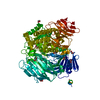
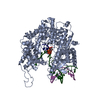
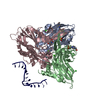

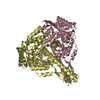
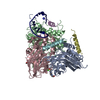
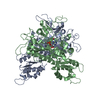

 PDBj
PDBj



